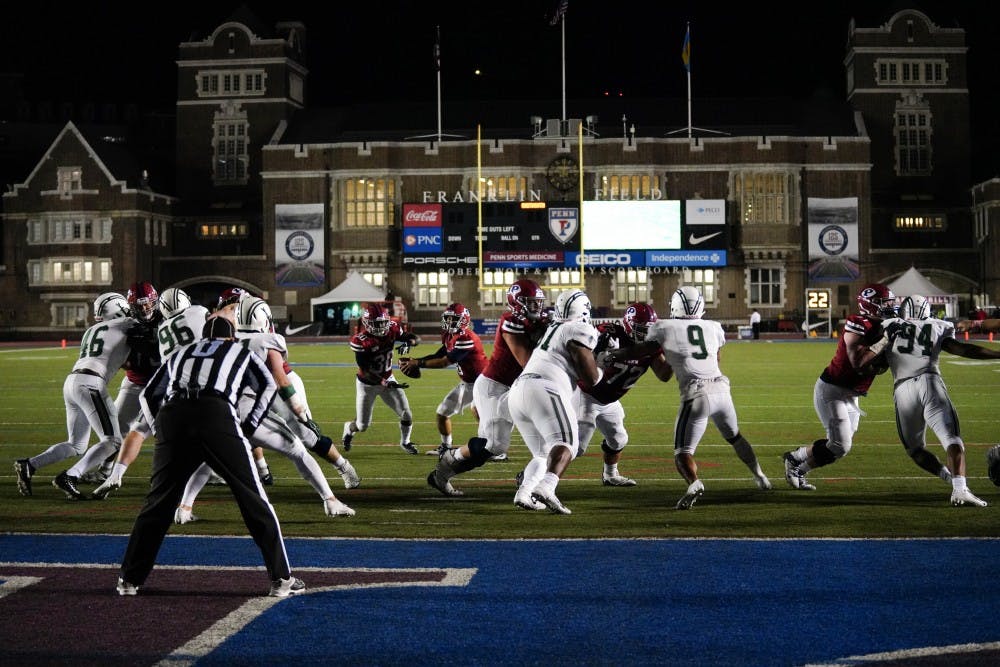
Under senior quarterback Nick Robinson, the Quakers have gone 6-for-14 on fourth down this season.
Credit: Chase SuttonIt’s fourth and goal from the opponent’s one-yard line. On one hand, a field goal would extend the lead, but it would remain a one-possession game. On the flip side, a touchdown would make it a two-possession game. The decision is put in your hands. What are you going to do?
In the sport of football, fourth-down plays and two-point conversions are becoming increasingly important to the offensive strategy and game plan. In simple terms, a successful fourth down or two-pointer can be the turning point or deciding factor in a tight game. However, the decision to go for it is by no means an easy one.
An unsuccessful fourth down or two-point conversion can just as easily swing the momentum to the opposing team — the reason why teams struggle with the decision. And for Penn coach Ray Priore, it’s no different.
“I think it’s important to be smart on all downs, fourth down included. There are times where it makes sense to go for it, and there are times it doesn’t make sense," Priore said. “It’s all driven by where the ball is on the football field, score, and time of the game."
At the season’s halfway mark, the Quakers are 6-for-14 on fourth down attempts. At an underwhelming 42.9%, the Red and Blue are last in the Ivy League in this category. To put that into perspective, Ivy-leading Cornell is currently converting 81.8% of its attempts, almost twice that of Penn.
This marks the second year in a row in which the Quakers have found themselves sitting at the bottom of this metric. A year ago, the Red and Blue found themselves 0-for-8 in converting fourth downs. However, Penn was ranked first in the category just two years ago.
In terms of two-point conversions, Penn has only attempted two so far this year. The first was an unsuccessful attempt in the final minutes of the season opener against Delaware, which proved costly in the 28-27 loss. The second was good but came late in the fourth quarter in the team's loss to Dartmouth.
While it’s up to Priore to decide whether to go for it on a fourth down or two-point conversion, offensive coordinator Kevin Morris is responsible for determining the play call.
“It’s all part of Coach Morris’ script. He’ll go into it understanding on fourth-and-short yardage situations — that could be from fourth and 1 to fourth and 5 — that you’re going to have a selection of plays depending where you are on the field, and the play is going to change depending on the opponent that we are playing that week,” Priore said.
At the end of the day, a fourth down or two-point conversion is the same as any other play during the course of a game in Priore’s book. There are plays ready to be called and depending on what the defense is showing, adjustments will be made. If you execute it successfully, you move the ball forward — it’s that simple.
“You have some plays preset and then you have some that you feel would work best against the team that you’re playing," Priore said. “What do they do in those situations — do they blitz, do they play soft coverage, do they play man-to-man, do they play zone? Everything is predicated on what you anticipate them doing. But that could be said about every down. Every down is treated that way so you don’t really treat fourth down or two-point conversions any differently.”
“I think that anytime you go for it on fourth down or go for two, it’s exciting. As a player, you like it because you get to stay on the field and roll the dice a little bit,” senior quarterback Nick Robinson added.
When it’s all said and done, fourth downs and two-point conversions are fun to watch. They add an element of risk into a football game, especially when the outcome of the game all comes down to a single play.
The Daily Pennsylvanian is an independent, student-run newspaper. Please consider making a donation to support the coverage that shapes the University. Your generosity ensures a future of strong journalism at Penn.
Donate






